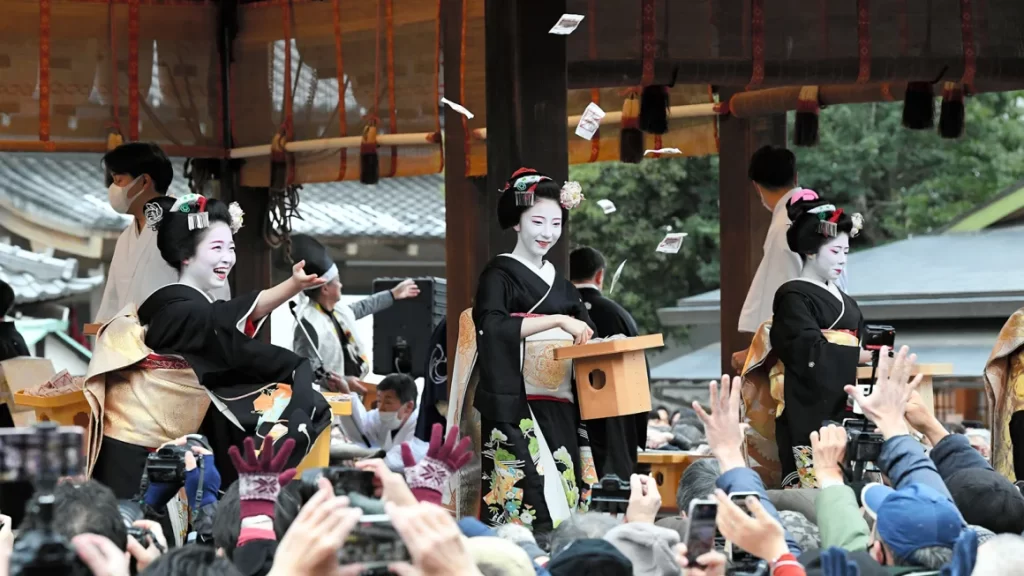News
Preserving Elegance: Kyoto’s Ongoing Battle Against the “Geisha Paparazzi”
In the enchanting city of Kyoto, where tradition gracefully intertwines with modernity, the presence of geisha and maiko is not merely a cultural legacy but a living, breathing art form. These women, adept in Japanese traditional arts such as singing, dancing, and playing musical instruments, captivate audiences, creating an atmosphere of refined entertainment for patrons as they indulge in dining and revelry. Gion, a picturesque quarter of Kyoto, stands as the stage for this captivating spectacle, where geishas elegantly traverse charming streets adorned in their traditional kimonos and makeup. Let’s find out with nowglas.

However, the allure of these geisha commutes has given rise to an unwelcome phenomenon – the “geisha paparazzi.” Tourists, drawn to the beauty of the traditional scenes, often find themselves inadvertently intrusive as they attempt to capture candid shots of the geisha and maiko. What begins as well-intentioned enthusiasm has, at times, crossed the boundaries of respect and cultural understanding.
Kyoto’s struggle with the “geisha paparazzi” reached a tipping point in 2019, with reports of disruptive behavior ranging from pulling at kimonos to chasing with cameras and smartphones, and even instances of physical harassment. In response, Gion implemented various measures, including the placement of signs and notices prohibiting photography, accompanied by warnings of fines amounting to ¥10,000 ($67).

Despite these efforts, Isokazu Ota, representative secretary of the Gion-town South Side District Council, reveals that the issue has escalated with the return of mass tourism after the pandemic. Enforcing the fine has proven challenging, leading to a proposal to close off small side alleys to tourists by April 2024. However, the main thoroughfare, Hanamikoji, remains a public street and thus exempt from the photography ban, presenting a complex challenge in striking the right balance.
The complexity of this issue lies in the difficulty of communicating and enforcing rules to a diverse group of tourists. Signs in three languages, including English, are in place, explaining the prohibition of geisha photography without a permit. Despite these efforts, Ota points out the challenges of reaching tourists, particularly those waiting in prohibited areas.
In an effort to find a comprehensive solution, Ota suggests requiring tourists in Gion to have Japanese tour guides, emphasizing the role of education in promoting respectful behavior. This proposed approach aligns with a growing trend where communities facing similar challenges have opted for educational initiatives to curb disruptive tourist behavior.
Drawing parallels with Hanoi’s “train street” and Easter Island’s Moai sculptures, both victims of social media-driven overtourism, cities have taken steps to safeguard cultural heritage. Hanoi ordered the closure of cafes along the popular train street due to safety concerns, erecting barricades to restrict access. Easter Island, grappling with inappropriate photo etiquette, slashed tourist visas and implemented designated paths to protect its iconic Moai sculptures.
In Gion, the proposed education-centric approach aims to strike a balance between preserving the enchanting traditions of geisha culture and accommodating the curiosity of visitors. Ota’s vision involves fostering an environment where tourists can appreciate and interact with maiko and geisha respectfully, without resorting to intrusive practices.

As Kyoto navigates the delicate interplay of tradition and tourism, the quest to mitigate the impact of the “geisha paparazzi” serves as a microcosm of global efforts to preserve cultural treasures while embracing the benefits of travel. The challenge lies in finding a harmonious coexistence between tradition and tourism, where education becomes the bridge that connects the past with the present, ensuring a legacy that endures with dignity and respect.
In this global context, the struggle faced by Kyoto is reflective of the broader challenges associated with balancing cultural preservation and the influx of tourists seeking unique and authentic experiences. The clash between the allure of tradition and the invasion of privacy encapsulates a dilemma that transcends borders and cultures.
See more: Patmos: Unveiling the Spiritual Tapestry of the Aegean Archipelago
In exploring potential solutions, it becomes evident that the key lies not only in restrictive measures but in cultivating an understanding among tourists about the cultural significance and sensitivities of the places they visit. Educational initiatives, such as guided tours with local experts, can play a pivotal role in bridging this gap and fostering responsible tourism.
Furthermore, the case of Kyoto’s “geisha paparazzi” underscores the need for a nuanced and adaptive approach that considers the evolving dynamics of tourism. As the world emerges from the shadow of the pandemic, travel patterns and behaviors are undergoing transformation, requiring destinations to reassess their strategies for managing tourist influx.
The proposed closure of small side alleys in Gion raises questions about the potential impact on the overall visitor experience. While this measure aims to restrict access and protect the privacy of geisha and maiko, it also calls for careful consideration of the broader implications on the tourism ecosystem. Striking the right balance between safeguarding cultural heritage and ensuring a positive experience for visitors is a delicate dance that demands thoughtful planning and community engagement.
Kyoto’s ongoing battle against the “geisha paparazzi” serves as a case study for destinations worldwide, urging them to reevaluate their approaches to managing tourism. It is an invitation to engage in a dialogue that goes beyond restrictions and fines, focusing on building connections between visitors and local communities.
In essence, the challenge faced by Kyoto encapsulates the essence of responsible and sustainable tourism – an endeavor that prioritizes cultural preservation, community well-being, and the creation of meaningful experiences for travelers. As the city seeks to preserve the elegance of its geisha culture, it beckons the world to embark on a journey where tourism becomes a force for good, respecting traditions and fostering mutual understanding.
See more: Israeli Forces Not Expected to Enter Rafah at the Beginning of Ramadan, Says Biden Administration
